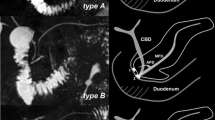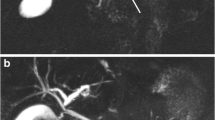Abstract
Purpose
To determine if T1-weighted MR signal of the pancreas can be used to detect early CP.
Methods
A retrospective analysis was performed on 51 suspected CP patients, who had both secretin-enhanced magnetic resonance cholangiopancreatography (S-MRCP) and an intraductal secretin stimulation test (IDST). There were 29 patients in normal and 22 patients in the low bicarbonate group. Bicarbonate level, total pancreatic juice volume, and excretory flow rate were recorded during IDST. Signal intensity ratio of pancreas (SIR), fat signal fraction, pancreatograms findings, and grade of duodenal filling were recorded on S-MRCP by two blinded radiologists.
Results
There was a significant difference in the signal intensity ratio of the pancreas to spleen (SIRp/s) between the normal and low bicarbonate groups (p < 0.0001). A significant positive correlation was found between pancreatic fluid bicarbonate level and SIRp/s (p < 0.0001). SIRp/s of 1.2 yielded sensitivity of 77% and specificity of 83% for detection of pancreatic exocrine dysfunction (AUC: 0.89).
Conclusion
T1-weighted MR signal of the pancreas has a high sensitivity and specificity for the detection of parenchymal abnormalities related to exocrine dysfunction and can therefore be helpful in evaluation of suspected early CP.




Similar content being viewed by others
References
Yadav D, Timmons L, Benson JT, Dierkhising RA, Chari ST (2011) Incidence, prevalence, and survival of chronic pancreatitis: a population-based study. Am J Gastroenterol 106(12):2192–2199. doi:10.1038/ajg.2011.328
Buchler MW, Martignoni ME, Friess H, Malfertheiner P (2009) A proposal for a new clinical classification of chronic pancreatitis. BMC Gastroenterol 9:93. doi:10.1186/1471-230X-9-93
Forsmark CE (2000) The diagnosis of chronic pancreatitis. Gastrointest Endosc 52(2):293–298. doi:10.1067/mge.2000.106889
Cote GA, Smith J, Sherman S, Kelly K (2013) Technologies for imaging the normal and diseased pancreas. Gastroenterology 144(6):1262–1271 e1261. doi:10.1053/j.gastro.2013.01.076
Chowdhury RS, Forsmark CE (2003) Review article: pancreatic function testing. Aliment Pharmacol Therapeutics 17(6):733–750
Lowenfels AB, Sullivan T, Fiorianti J, Maisonneuve P (2005) The epidemiology and impact of pancreatic diseases in the United States. Curr Gastroenterol Rep 7(2):90–95
Manes G, Kahl S, Glasbrenner B, Malfertheiner P (2000) Chronic pancreatitis: diagnosis and staging. Annali italiani di chirurgia 71(1):23–32
Nichols MT, Russ PD, Chen YK (2006) Pancreatic imaging: current and emerging technologies. Pancreas 33(3):211–220. doi:10.1097/01.mpa.0000227912.71202.2c
Toskes PP (1999) Update on diagnosis and management of chronic pancreatitis. Curr Gastroenterol Rep 1(2):145–153
Dominguez-Munoz JE, Alvarez-Castro A, Larino-Noia J, Nieto L, Iglesias-Garcia J (2012) Endoscopic ultrasonography of the pancreas as an indirect method to predict pancreatic exocrine insufficiency in patients with chronic pancreatitis. Pancreas 41(5):724–728. doi:10.1097/MPA.0b013e31823b5978
Alvarez-Sanchez MV, Jenssen C, Faiss S, Napoleon B (2014) Interventional endoscopic ultrasonography: an overview of safety and complications. Surg Endosc 28(3):712–734. doi:10.1007/s00464-013-3260-5
Stevens T, Lopez R, Adler DG, et al. (2010) Multicenter comparison of the interobserver agreement of standard EUS scoring and Rosemont classification scoring for diagnosis of chronic pancreatitis. Gastrointest Endosc 71(3):519–526. doi:10.1016/j.gie.2009.10.043
Walsh TN, Rode J, Theis BA, Russell RC (1992) Minimal change chronic pancreatitis. Gut 33(11):1566–1571
Cappeliez O, Delhaye M, Deviere J, et al. (2000) Chronic pancreatitis: evaluation of pancreatic exocrine function with MR pancreatography after secretin stimulation. Radiology 215(2):358–364
Catalano MF, Lahoti S, Geenen JE, Hogan WJ (1998) Prospective evaluation of endoscopic ultrasonography, endoscopic retrograde pancreatography, and secretin test in the diagnosis of chronic pancreatitis. Gastrointest Endosc 48(1):11–17
Denyer ME, Cotton PB (1979) Pure pancreatic juice studies in normal subjects and patients with chronic pancreatitis. Gut 20(2):89–97
Ochi K, Harada H, Mizushima T, Tanaka J, Matsumoto S (1997) Intraductal secretin test is as useful as duodenal secretin test in assessing exocrine pancreatic function. Dig Dis Sci 42(3):492–496
Gregg JA (1982) The intraductal secretin test: an adjunct to ERCP. Gastrointest Endosc 28(3):199–203
Matos C, Metens T, Deviere J, et al. (1997) Pancreatic duct: morphologic and functional evaluation with dynamic MR pancreatography after secretin stimulation. Radiology 203(2):435–441
Zou KH, Tuncali K, Silverman SG (2003) Correlation and simple linear regression. Radiology 227(3):617–622. doi:10.1148/radiol.2273011499
Witt H, Apte MV, Keim V, Wilson JS (2007) Chronic pancreatitis: challenges and advances in pathogenesis, genetics, diagnosis, and therapy. Gastroenterology 132(4):1557–1573. doi:10.1053/j.gastro.2007.03.001
Winston CB, Mitchell DG, Outwater EK, Ehrlich SM (1995) Pancreatic signal intensity on T1-weighted fat saturation MR images: clinical correlation. J Magn ResonImaging 5(3):267–271
Trikudanathan G, Walker SP, Munigala S, et al. (2015) Diagnostic performance of contrast-enhanced mri with secretin-stimulated mrcp for non-calcific chronic pancreatitis: a comparison with histopathology. Am J Gastroenterol 110(11):1598–1606. doi:10.1038/ajg.2015.297
Mitchell DG, Winston CB, Outwater EK, Ehrlich SM (1995) Delineation of pancreas with MR imaging: multiobserver comparison of five pulse sequences. J Magn ResonImaging 5(2):193–199
Sica GT, Miller FH, Rodriguez G, McTavish J, Banks PA (2002) Magnetic resonance imaging in patients with pancreatitis: evaluation of signal intensity and enhancement changes. J Magn ResonImaging 15(3):275–284
Watanabe H, Kanematsu M, Tanaka K, et al. (2014) Fibrosis and postoperative fistula of the pancreas: correlation with MR imaging findings–preliminary results. Radiology 270(3):791–799. doi:10.1148/radiol.13131194
Balci NC, Alkaade S, Magas L, Momtahen AJ, Burton FR (2008) Suspected chronic pancreatitis with normal MRCP: findings on MRI in correlation with secretin MRCP. J Magn Reson Imaging 27(1):125–131. doi:10.1002/jmri.21241
Balci NC, Smith A, Momtahen AJ, et al. (2010) MRI and S-MRCP findings in patients with suspected chronic pancreatitis: correlation with endoscopic pancreatic function testing (ePFT). J Magn Reson Imaging 31(3):601–606. doi:10.1002/jmri.22085
Bali MA, Sztantics A, Metens T, et al. (2005) Quantification of pancreatic exocrine function with secretin-enhanced magnetic resonance cholangiopancreatography: normal values and short-term effects of pancreatic duct drainage procedures in chronic pancreatitis. Initial Results. Eur Radiol 15(10):2110–2121. doi:10.1007/s00330-005-2819-5
Sainani NI, Kadiyala V, Mortele K, et al. (2015) Evaluation of qualitative magnetic resonance imaging features for diagnosis of chronic pancreatitis. Pancreas 44(8):1280–1289. doi:10.1097/MPA.0000000000000466
Sherman S, Freeman ML, Tarnasky PR, et al. (2014) Administration of secretin (RG1068) increases the sensitivity of detection of duct abnormalities by magnetic resonance cholangiopancreatography in patients with pancreatitis. Gastroenterology 147(3):646–654.e642. doi:10.1053/j.gastro.2014.05.035
Alkaade S, Cem Balci N, Momtahen AJ, Burton F (2008) Normal pancreatic exocrine function does not exclude MRI/MRCP chronic pancreatitis findings. J Clin Gastroenterol 42(8):950–955. doi:10.1097/MCG.0b013e31812f4ef5
Draganov P, Patel A, Fazel A, Toskes P, Forsmark C (2005) Prospective evaluation of the accuracy of the intraductal secretin stimulation test in the diagnosis of chronic pancreatitis. Clin Gastroenterol Hepatol 3(7):695–699
Author information
Authors and Affiliations
Corresponding author
Ethics declarations
Funding
No funding was received for this work.
Conflict of interest
Authors do not have any relevant conflict of interest with this study.
Ethical approval
All procedures performed in studies involving human participants were in accordance with the ethical standards of the institutional and/or national research committee and with the 1964 Helsinki declaration and its later amendments or comparable ethical standards. T1
his article does not contain any studies with animals performed by any of the authors.
Informed consent
Requirement for an informed consent was waived by the IRB.
Rights and permissions
About this article
Cite this article
Tirkes, T., Fogel, E.L., Sherman, S. et al. Detection of exocrine dysfunction by MRI in patients with early chronic pancreatitis. Abdom Radiol 42, 544–551 (2017). https://doi.org/10.1007/s00261-016-0917-2
Published:
Issue Date:
DOI: https://doi.org/10.1007/s00261-016-0917-2




